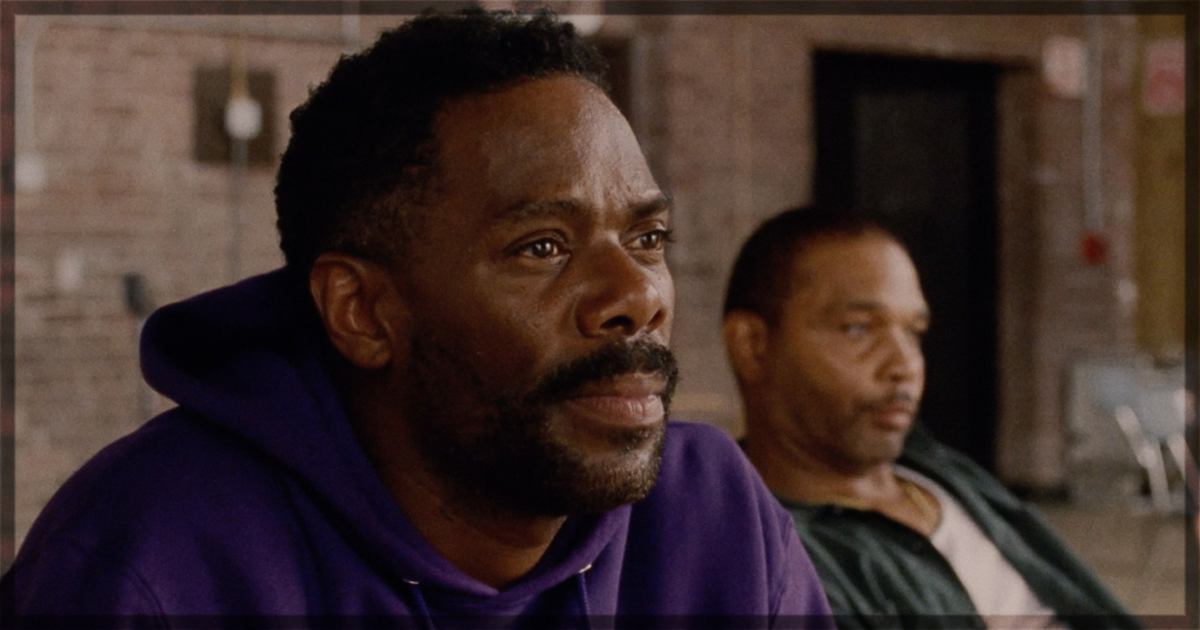Greg Kwedar’s Sing Sing opens from the wings of a theatre. The camera moves hazily through sparkling streamers hanging from the stage ceiling before emerging on John “Divine G” Whitfield (Colman Domingo) performing a monologue from Shakespeare’s A Midsummer Night’s Dream. Rapturous applause breaks out, and the entire cast joins him at the footlights to take their bows. They go backstage, joking and chatting as they take off their costumes and put their props away.
It soon becomes apparent this is no ordinary theatre or performance. The performers have changed back into dark green uniforms and lined up for roll call. Silently, they step forward when their block is called and walk single file through the corridors back to individual cells. They are not actors performing at a professional (or even purpose-built) theatre but inmates at Sing Sing Correctional Facility.
Whitfield (a real person on whom this film is loosely based) is one of the founders and organizers of the prison’s drama program, which has a loyal group of participants who speak excitedly about the next project they will embark on. This excitement flows over to recruiting new members, who join the group’s drama exercises with trepidation at first before picking up everyone else’s infectious enthusiasm. Picking this with the guidance of an external facilitator/director is a boisterous process, where opinions on the type of show they should do next are shared (no tragedies, this time) and eventually incorporated into a time-traveling mashup of genres, characters, and places. Sing Sing follows the genesis of this original script and performance, based on a real production mounted by Rehabilitation Through the Arts (RTA) at Sing Sing Correctional Facility and other prisons throughout the United States. RTA’s mantra is “trust the process”, a phrase familiar to the participants whether they work on comedies or tragedies, Shakespearian classics or new works.
Sing Sing Correctional Facility sits on the banks of the Hudson River at one of its widest sections, just outside Ossining, New York. Exterior shots from high above the facility complex – situating its expansiveness against a hilly, rural landscape – capture the rich natural beauty of the area’s foliage and avian life, and the tranquillity in the river’s ceaseless flow is a world apart from the daily life of Sing Sing inmates. In an early scene, Whitfield is feeding the birds in the yard when the prison siren blares, causing him to reflexively throw himself to the ground and stay put on his stomach until the alarm ceases. This is not an environment innately conducive to creativity or spontaneity.
Domingo is the only “professional” actor on screen. The rest of the cast is comprised of RTA alumni, most making their professional screen debuts, often playing themselves. They are all uniformly magnetic presences who hold their own against Oscar-nominee Domingo, who for his part effortlessly melds to match their world and energy. This is a masterclass in casting and ensemble work, and it is clear the entire creative and performance team has trusted the process with the same openhearted generosity and selflessness in creation.
Trusting the process also extends to the production elements. Developments in the plot, or in various characters’ parole hearings, are not always explicitly filled in but emerge in natural conversations or a single meaningful shot, captured by cinematographer Patrick Scola. The latter device veers occasionally towards the heavy-handed, but the film steers clear of overwrought sentimentality largely thanks to its understated sound world and masterful performances. Bryce Dessner’s score marks a departure from his previous excellent screen work, favoring somber horns over strings to enhance the reflective, transformative mood and the possibilities of these lives on hold. Parker Laramie’s editing is unobtrusive, moving between close and wide shots that mirror characters’ emotional states. While Sing Sing does not have large-scale effects or show events of epic proportions, it is worth a visit to the cinema to see rather than waiting for home video – the overall cumulative effect is quietly impactful and deserves the biggest, most respectful environment for its viewing.
The biggest flaw possible to find in Sing Sing is a relative predictable progression of events, but this is a common occurrence when fitting real people and experiences into 106 minutes and a linear plot structure. That said, Sing Sing is not a biopic of Whitfield and avoids that genre’s hero’s journey pitfalls. The quest is the play.
Companies like RTA in New York, The Actors’ Gang Prison Project in California, and Clean Break in the United Kingdom do exceptional, vital work not only for rehabilitation within the criminal justice system but for creativity, expression, and proof that the arts do not belong to people with certain educational and material privileges. Sing Sing will hopefully bring the work of the RTA and similar organizations around the world to a wider audience. Few films deserve the monikers “important,” “vital,” or “must-see,” but this may be one of them. Aside from its larger social importance, Sing Sing is also an excellent drama charting one wholly original theatrical production from genesis through final performance, and its impact on the lives shaping and shaped by it along the way.
Sing Sing recently screened at the Edinburgh International Film Festival.
Learn more about the film at the Edinburgh site for the title.


